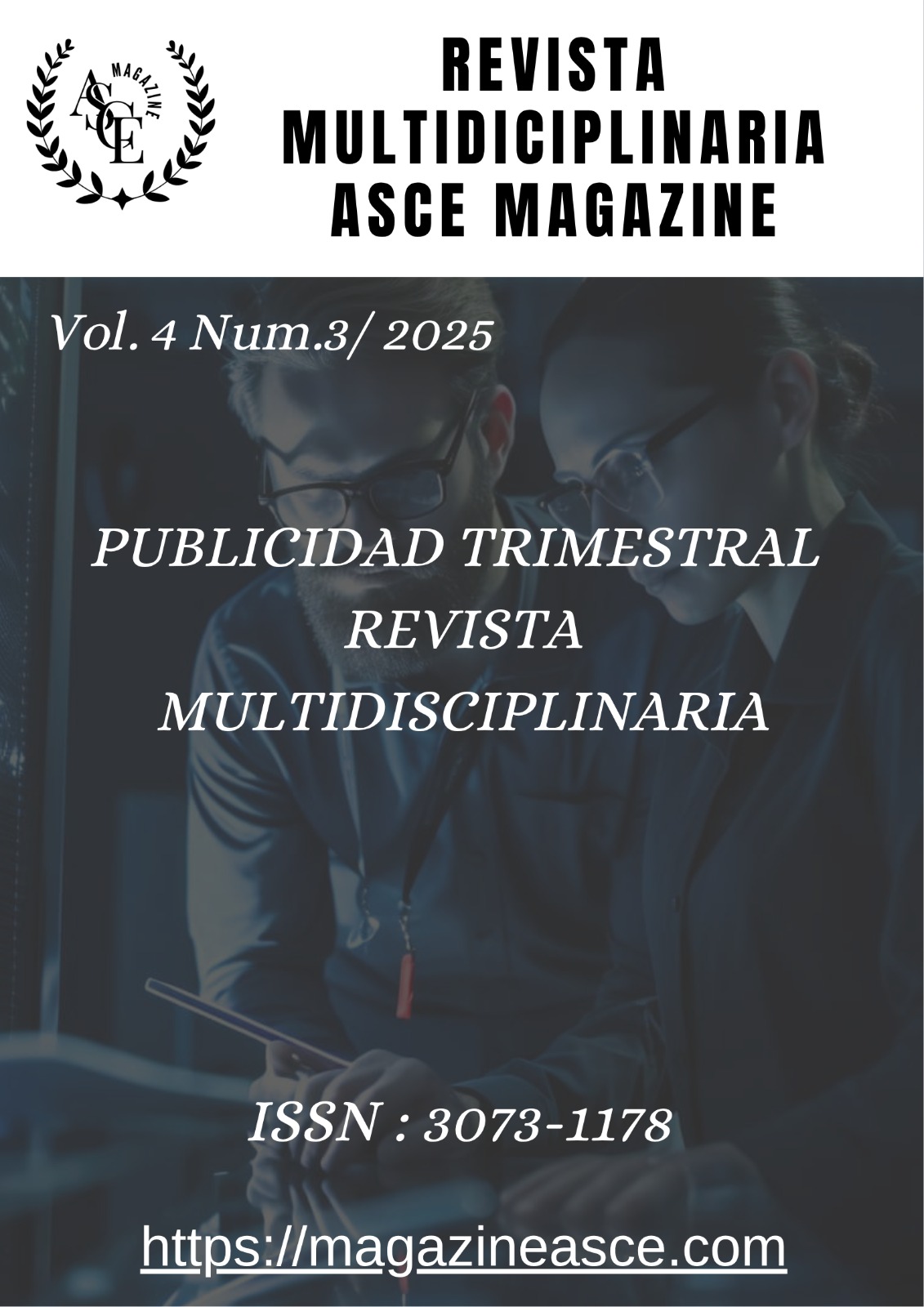¿Puede el Aprendizaje Automático Predecir Brechas de Ciberseguridad en los Sistemas de Información Empresariales? Un análisis de aprendizaje supervisado
DOI:
https://doi.org/10.70577/ASCE/333.352/2025Palabras clave:
Ciberseguridad; Aprendizaje Automático; Análisis Predictivo; Factor Humano; Bosque Aleatorio (Random Forest).Resumen
Este artículo investiga la capacidad del aprendizaje automático supervisado para predecir brechas de ciberseguridad en entornos empresariales. Mediante un análisis comparativo de dos modelos, la Máquina de Vectores de Soporte (SVM) y el Bosque Aleatorio (Random Forest), el estudio evalúa su eficacia en un conjunto de datos simulado que integra variables técnicas, contextuales y de comportamiento humano. Ambos modelos alcanzan una notable precisión global del 88%, aunque con fortalezas distintas: el SVM destaca por su alta sensibilidad para detectar brechas reales, mientras que el Bosque Aleatorio demuestra una consistencia y fiabilidad superiores. El hallazgo más significativo proviene del análisis de importancia de variables del Bosque Aleatorio, que revela que el factor humano —representado por la tasa de clics en phishing— es el predictor más influyente, acaparando el 42% del poder predictivo. Este supera considerablemente a los factores técnicos como la gravedad o el número de vulnerabilidades. El estudio concluye que, si bien el aprendizaje automático es una herramienta potente para la predicción, su mayor valor reside en identificar los verdaderos focos de riesgo. Por ello, se recomienda que las estrategias de ciberseguridad se reorienten para priorizar la mitigación del riesgo humano, reconociéndolo no solo como una vulnerabilidad, sino como el principal indicador predictivo de un incidente.
Descargas
Citas
T. S., -, Theyjakshaya. D., & -, V. Vardhini. A. (2024). Cyber hacking breaches prediction and detection using machine learning. International Journal For Multidisciplinary Research, 6(3), 22653. https://doi.org/10.36948/ijfmr.2024.v06i03.22653 DOI: https://doi.org/10.36948/ijfmr.2024.v06i03.22653
Department of Professional Security Studies, New Jersey City University, , Dhaka, Bangladesh. (2024). Comparative analysis of machine learning algorithms for predicting cybersecurity attack success: A performance evaluation. The American Journal of Engineering and Technology, 6(9), 81–91. https://doi.org/10.37547/tajet/Volume06Issue09-10 DOI: https://doi.org/10.37547/tajet/Volume06Issue09-10
Jada, I., & Mayayise, T. O. (2024). The impact of artificial intelligence on organisational cyber security: An outcome of a systematic literature review. Data and Information Management, 8(2), 100063. https://doi.org/10.1016/j.dim.2023.100063 DOI: https://doi.org/10.1016/j.dim.2023.100063
Leveraging analytics to predict and prevent security breaches. (2025). Pavion. Retrieved July 11, 2025, from https://pavion.com/resource/leveraging-analytics-to-predict-and-prevent-security-breaches/
Machhindra, P. A., Vijay, B. N., Mahendra, B. S., Rahul, C. A., Anil, P. A., & Sunil, P. R. (2023). Enhancing cyber security through machine learning: A comprehensive analysis. 2023 4th International Conference on Computation, Automation and Knowledge Management (ICCAKM), 1–6. https://doi.org/10.1109/ICCAKM58659.2023.10449547 DOI: https://doi.org/10.1109/ICCAKM58659.2023.10449547
May, R. (2024, September 30). Machine learning algorithms in cybersecurity. Ramsac Ltd. https://www.ramsac.com/blog/machine-learning-algorithms-in-cybersecurity/
Niravkumar Dhameliya. (2024). Machine learning in cybersecurity: A comprehensive analysis of intrusion detection systems. Journal of Sustainable Solutions, 1(4), 38–42. https://doi.org/10.36676/j.sust.sol.v1.i4.22 DOI: https://doi.org/10.36676/j.sust.sol.v1.i4.22
Pujitha, K., Nandini, G., Sree, K. V. T., Nandini, B., & Radhika, D. (2023). Cyber hacking breaches prediction and detection using machine learning. 2023 2nd International Conference on Vision Towards Emerging Trends in Communication and Networking Technologies (ViTECoN), 1–6. https://doi.org/10.1109/ViTECoN58111.2023.10157462 DOI: https://doi.org/10.1109/ViTECoN58111.2023.10157462
Raju, S. (2024). Adaptive security through machine learning with predictive approach to modern cyber threats. International Journal of Computer Applications, 186(50), 6–12. https://doi.org/10.5120/ijca2024924185 DOI: https://doi.org/10.5120/ijca2024924185
Singh, K., & Jha, S. (2021). Cyber threat analysis and prediction using machine learning. 2021 3rd International Conference on Advances in Computing, Communication Control and Networking (ICAC3N), 1981–1985. https://doi.org/10.1109/ICAC3N53548.2021.9725445 DOI: https://doi.org/10.1109/ICAC3N53548.2021.9725445
Srivastava, T. (2019, August 6). 12 important model evaluation metrics for machine learning everyone should know(Updated 2025). Analytics Vidhya. https://www.analyticsvidhya.com/blog/2019/08/11-important-model-evaluation-error-metrics/
Susheela, S., Chandra, N. S., & Priyan, S. S. (2024). Predictive analytics-enabled cyber attack detection. International Journal of Innovative Science and Research Technology (IJISRT), 1242–1247. https://doi.org/10.38124/ijisrt/IJISRT24APR705 DOI: https://doi.org/10.38124/ijisrt/IJISRT24APR705
Tulsyan, R., Shukla, P., Singh, T., & Bhardwaj, A. (2024). Cyber security threat detection using machine learning. INTERANTIONAL JOURNAL OF SCIENTIFIC RESEARCH IN ENGINEERING AND MANAGEMENT, 08(10), 1–6. https://doi.org/10.55041/IJSREM37949 DOI: https://doi.org/10.55041/IJSREM37949
Wang, D. M. (2023, September 1). Machine learning in cybersecurity. Perspectives. https://www.paloaltonetworks.com/perspectives/the-future-of-machine-learning-in-cybersecurity/
Descargas
Publicado
Cómo citar
Número
Sección
Licencia
Derechos de autor 2025 Sonia Patricia Córdovez Machado, John Javier Cruz Garzón, Cristian Luis Inca Balseca

Esta obra está bajo una licencia internacional Creative Commons Atribución-NoComercial-SinDerivadas 4.0.






























